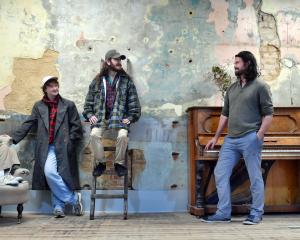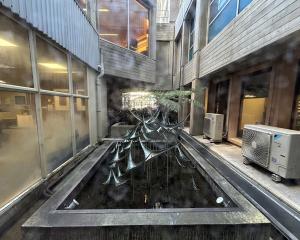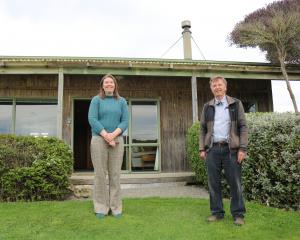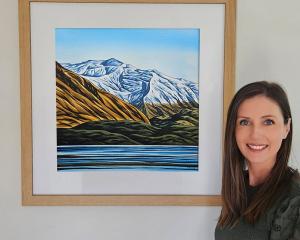In this week's Art Seen, Robyn Maree Pickens looks at exhibitions from Kalisolaite ’Uhila, Kim Pieters, and Patrick Pound.
 Kapa Ma (detail), by Kalisolaite ’Uhila
''Kapa Ma'', Kalisolaite 'Uhila (Dunedin Public Art Gallery)
Kapa Ma (detail), by Kalisolaite ’Uhila
''Kapa Ma'', Kalisolaite 'Uhila (Dunedin Public Art Gallery)

Kalisolaite 'Uhila is almost halfway through his three-month residency as the Dunedin Public Art Gallery's 2019 Aotearoa New Zealand Visiting Artist.
Over the past six weeks, the performance artist has transformed some of the large metal tins of kapa ma (or cabin bread biscuits) into sculptures by way of periodic drumming performances in the gallery.
At the beginning of 'Uhila's residency, the large metal tins of Lees Quality Cabin Bread Biscuits were swathed in shipping plastic and sitting on a wooden pallet.
Now the industrial, hermetic quality of the 5 x 5 x 3 cube has been breached and the unitary block centred in the middle of a low white platform is still in the process of being replaced by single, beaten tins arranged in rows.
The (usually) Auckland-based, Tongan artist has used wooden sticks to beat the tins into sculptural forms. 'Uhila's sculptural process takes place during the act of performance rather in the relative seclusion and privacy of the artist's studio.
'Uhila's choice of kapa ma/cabin bread is, like the artist's previous performance with a piglet (''Pigs in the Yard'', 2011), an astute fusion of Tongan and Western cultural references. Cabin bread is a staple of Pacific (and other) households, while the metal tin references Andy Warhol's embrace of mass production and Aotearoa artist Michel Tuffery's use of flattened corned beef tins to create sculptures. It is through drumming, common to Tongan culture, that 'Uhila performs sculptural transformation.
 Pastoral, 2018, by Kim Pieters
''The Guitar Lesson'', Kim Pieters (RDS)
Pastoral, 2018, by Kim Pieters
''The Guitar Lesson'', Kim Pieters (RDS)

Once a year, Kim Pieters releases a new body of painting from her studio that may have been accruing readiness for six to 12 months. This delayed release is akin to an invisible ''curing'' in which the work acquires an intangible patina before it encounters the wider world.
Pieters' latest release is titled ''The Guitar Lesson''. This suite of eight new paintings can be seen as a response to the work of Spanish painter Joan Miro and to a particularly insightful (even revisionist) catalogue of Miro's oeuvre titled I'm Going to Smash Their Guitar. Many of Pieters' titles are taken from this catalogue of Miro's work but were applied retrospectively, after the paintings were completed.
As is typical in Pieters' naming process, there is a productive gap between the painting and the title it receives. The title, which is often oblique, and even on first glance unrelated, is intentionally bestowed to function as an additional thinking or intuitive space. It is not intended to uncritically add like to like.
One painting in Pieters' suite, titled Pastoral, comprises a combination of line, shape and form in direct and subtle relationships.
The painting does not immediately evoke a typical pastoral scene, and the title exists as another layer to explore the group of non-representational gestures characteristic of Pieters' improvisatory abstraction. Go to see an atom fall through space (and other associations).
 Summer Holiday 1962, by Patrick Pound
''Summer Holiday 1962'', Patrick Pound (DPAG Rear Window)
Summer Holiday 1962, by Patrick Pound
''Summer Holiday 1962'', Patrick Pound (DPAG Rear Window)

I wish I had fully engaged with Patrick Pound's video work ''Summer Holiday 1962'' before I read the accompanying wall text. The short video, which shows fleeting images of young men on holiday together, whether as friends or lovers, retains its grainy heritage as Super 8 footage despite its digital conversion.
This filmic heritage is important because it enables the viewer to situate themselves in a particular historical moment; in this case, 1986. Although, that said, the ''1962'' in the work's title could cause a measure of confusion (is this 1962 or 1986?). What I wondered after viewing the work, and reading it against the almost too-upbeat soundtrack of Cliff Richard's hit Summer Holiday, was whether the era evoked by the grainy images of men beside waterfalls, trees, hammocks, beaches and shorelines alerted me to the then risks of open displays of love and eroticism between men.
And moving through the 1980s to the unimaginable grief brought on by the Aids epidemic of that decade (in particular). That is, would I have been able to perceive the fragility and brittleness of this historical moment without reading the wall text? Possibly.
Possibly not. Rather than spell out the details of the wall text accompanying ''Summer Holiday 1962'', I encourage you to view the work in its entirety, and then read the wall text. This is the first time ''Summer Holiday 1962'' has been shown publicly since 1986.
-By Robyn Maree Pickens













